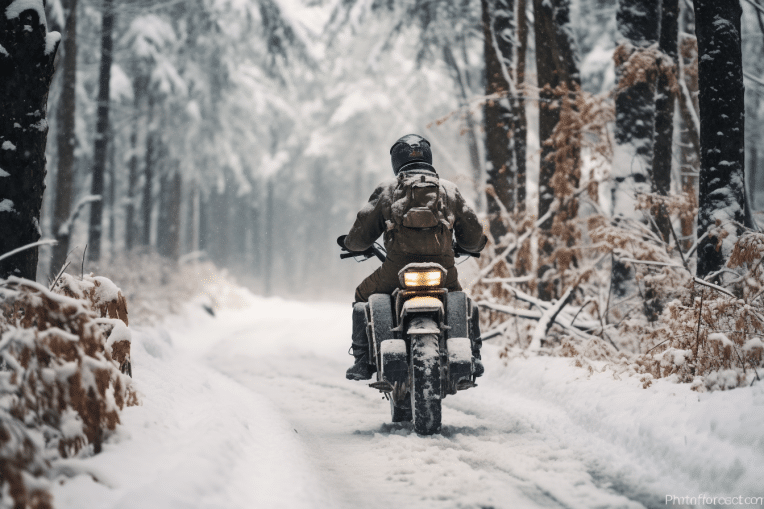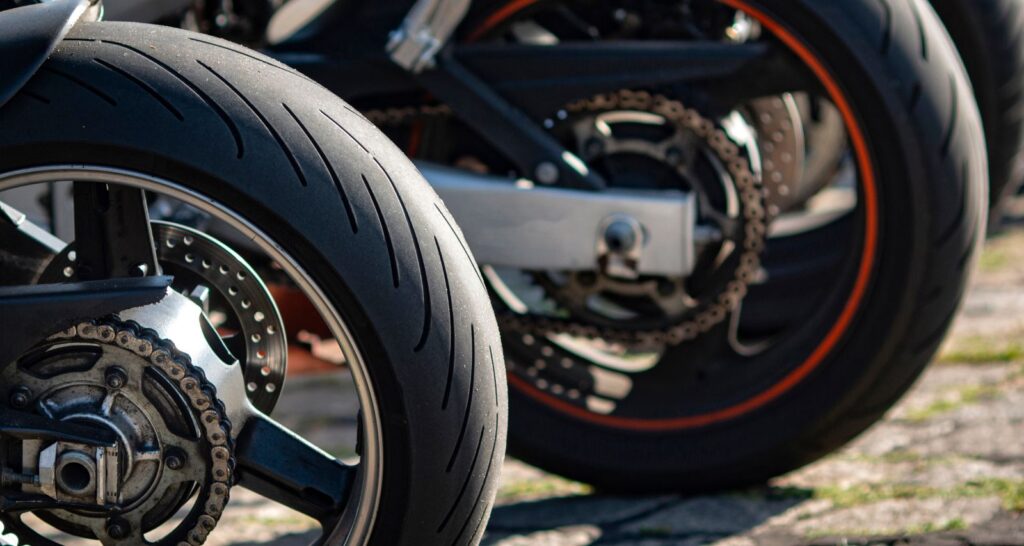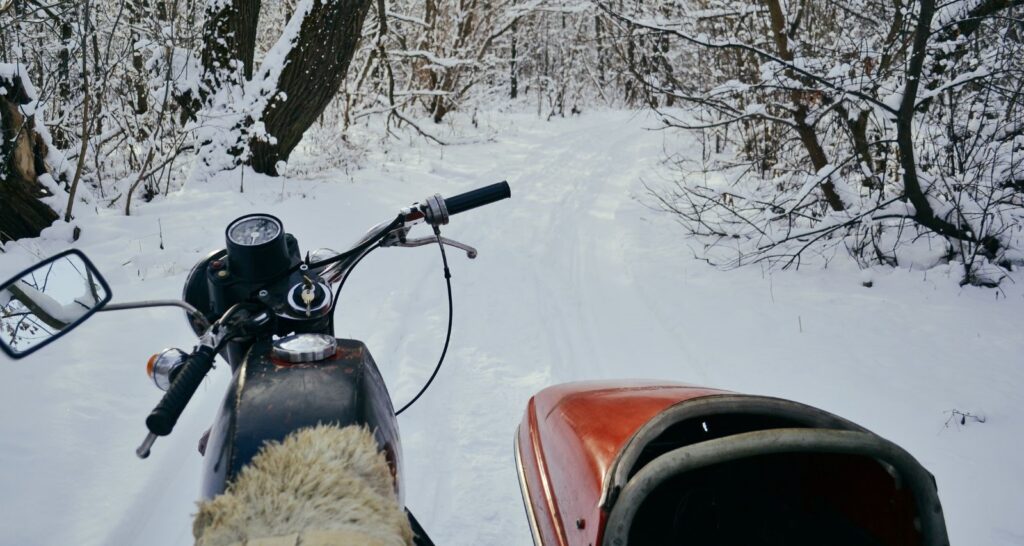Embracing The Chill of Winter Motorcycle Riding
Are you ready to challenge the elements and experience the thrill of winter motorcycle riding? As the temperature drops and snow blankets the landscape, the call of the open road remains irresistible to many riders. But venturing out in winter requires more than just a warm spirit; it demands careful preparation and specialized skills.
What is Winter Motorcycle Riding
Winter motorcycle riding is a thrilling adventure ride and demanding endeavor that takes the allure of motorcycling to a whole new level. It involves navigating roads and facing the elements during the coldest and often most challenging time of the year. While some riders choose to stow their bikes away during the winter months, a dedicated group of enthusiasts embraces the chill and continues to explore the world on two wheels.
This unique form of riding demands specialized skills, a keen sense of preparation, and a deep appreciation for the beauty of winter landscapes. It’s an experience that offers a stark contrast to the warm, carefree days of summer, and for those who dare to venture out, it can be both a physical and mental test, as well as a source of unforgettable memories.
The Winter Rider’s Essentials
Cold-Weather Gear
Riding in winter means bundling up. Layering your clothing is key to staying warm. Start with a moisture-wicking base layer, add an insulating mid-layer, and finish with a windproof and waterproof outer layer. Don’t forget heated gear, which can make a significant difference in staying comfortable during your ride. Invest in insulated, waterproof gloves to protect your hands from the biting cold.
Visibility
Reduced visibility is a concern during winter. Ensure your helmet has a clear face shield, and consider using anti-fog solutions to prevent condensation. Opt for high-visibility clothing with reflective elements, making you more noticeable to other road users.
Traction
Tires are a crucial component. Consider switching to winter or all-weather tires for better grip on cold, wet, or icy roads. Maintain proper tire pressure and check your tire tread regularly. Be extra cautious on potentially slippery surfaces.
Bike Prep
Ensure your motorcycle is winter-ready. Check the battery to avoid any cold-weather failures. Use anti-freeze designed for motorcycles and take precautions against corrosion. A clean and well-maintained bike is your best companion in winter.
Riding in the US States with Harsh Winters
Alaska
In the land of extreme cold, riding in winter is a true challenge. Icy roads and unpredictable weather are the norm. Always carry an emergency kit, including a communication device, in case of unforeseen situations.
Minnesota
The “Land of 10,000 Lakes” poses its own winter riding challenges. Be prepared for slippery roads and dress warmly. Use winter tires for improved traction.
Colorado
Navigating the Rockies during winter can be unpredictable. Sudden weather changes are common. Watch for black ice and always be ready for rapidly changing conditions.
North Dakota
The plains and frigid winds of North Dakota require riders to be well-equipped. Wear layers, use heated gear, and maintain your bike to withstand the cold.
Vermont
In the Green Mountain State, where snowfall is frequent, winter riding is not for the faint of heart. Be prepared for snow-covered roads and low temperatures.
Winter Riding Techniques
Smooth and Gentle Controls
One of the most important techniques for winter riding is to use smooth and gentle controls. Avoid abrupt acceleration and braking, as sudden movements can lead to skidding on slippery surfaces.
Importance of Being Flexible
Staying flexible is vital. Keep a relaxed posture and be prepared for sudden shifts in weight distribution. Being rigid can make the bike harder to control in unpredictable winter conditions.
Mind Your Blind Spots
Winter often means snowbanks and decreased visibility. Be extra cautious and regularly check your mirrors and blind spots. Know that other vehicles may have limited visibility as well.
Avoid Salt and Sand
Road treatment materials like salt and sand can be abrasive and corrosive to your bike. Avoid riding through them when possible, and if you encounter them, ensure a thorough cleaning of your motorcycle afterward.
Group Riding in Winter
Safety in Numbers
Riding in a group in winter can be safer. If something goes wrong, you have the support of fellow riders. The camaraderie can be reassuring, and you can share information about road conditions and potential hazards.
Formation and Spacing
When riding in a group during winter, maintain a safe distance between bikes. Riding in a staggered formation allows for better visibility and reaction time. Avoid tailgating and provide enough space for braking.
Communication
Effective communication is essential when riding as a group. Use hand signals to alert others to potential hazards or upcoming stops. Many riders also use intercom systems for real-time communication.
Emergency Preparedness
Riding with a group in winter is not just about safety; it’s about having a support system in case of emergencies. The buddy system can be invaluable in case of breakdowns or accidents. Ensure that everyone knows the plan and is equipped with the necessary emergency gear.
Staying Safe: Tips and Strategies
Weather Checks
Check the weather forecast before, during, and after your ride. Conditions can change rapidly, and staying informed about upcoming storms or temperature drops is crucial for a safe journey.
Road Conditions
Pay attention to road conditions. Monitor closures, accidents, and other hazards that may affect your route. If conditions deteriorate, consider adjusting your travel plans or seeking shelter.
Emergency Kit
Carry an emergency kit with essentials like first-aid supplies, a flashlight, communication devices, and items to keep you warm in case of an unexpected stop or breakdown.
Recognizing the Limits
Knowing your limits is essential. If conditions become too extreme or if you feel uncomfortable, it’s okay to call it a day. Your safety is the top priority.
The Takeaway
Start embracing the winter motorcycle riding challenge. This challenge is not for the faint of heart, but it offers a unique and exhilarating experience for those willing to take on the challenge. With the right gear, preparation, and riding techniques, you can conquer the cold and enjoy the open road even when the temperature drops.
Whether you’re riding in the icy wilderness of Alaska or navigating the snow-covered roads of Vermont, taking on the challenge of winter motorcycle riding demonstrates your unwavering commitment to the exhilarating world of two-wheeled adventure.




